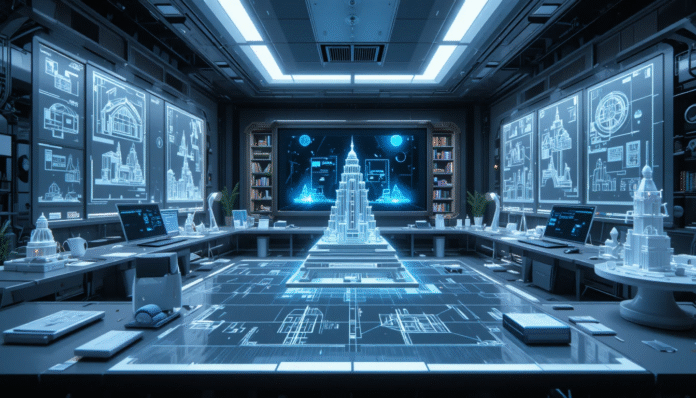It’s funny how one name can suddenly start popping up everywhere. You’re scrolling through design forums, maybe chatting with someone in the industry, and the name daniel r locke virtual aia slips into the conversation. You pause for a second, wondering why so many people seem drawn to this person’s approach to the new frontier of architecture.
The truth is, the architectural world is going through a massive shift. And Daniel is one of those people standing right in the middle of it—quietly but confidently shaping what the future of design might look like.
Understanding Who Daniel R Locke Virtual AIA Really Is
People use the phrase daniel r locke virtual aia to describe a digital-first architect who blends traditional design principles with advanced virtual tools. Instead of the old-school image of an architect hunched over a drafting table, Daniel works in an environment where models, spaces, and even entire buildings come alive through immersive digital platforms.
His role represents something bigger than a single person—it reflects a new generation of architects operating almost entirely in virtual space. These professionals aren’t bound by physical studios or local clients. They collaborate globally, design digitally, and deliver ideas faster than ever before.
And honestly, it’s easy to see why his name keeps surfacing. People are fascinated by architects who break free from old limitations.
Why Virtual Architects Are Reshaping the Industry
When you hear the term virtual AIA, it might sound futuristic, but it’s already happening. Architects like Daniel are proving that digital workflows are no longer optional—they’re essential.
The industry used to move slowly, weighed down by paperwork, long meetings, and endless revisions. Now clients want speed, clarity, and collaboration without the confusion. Virtual architects deliver all of that.
The beauty of this shift is that it doesn’t erase the artistry of architecture. It enhances it. The digital tools simply remove the friction between imagination and execution.
How Virtual AIA Professionals Work
Designing a space digitally isn’t just about creating 3D models. It’s a complete ecosystem of communication, simulation, and iteration. Professionals like Daniel rely on workflows that allow clients to step inside a concept long before construction begins.
A meeting might take place inside a virtual room. A design detail might be reviewed through a digital twin. A material change might update across the entire structure instantly. The agility of this process is the main reason the phrase daniel r locke virtual aia keeps gaining traction.
Clients appreciate seeing ideas come to life in front of them. And architects appreciate the freedom to refine a design without starting from scratch every time.
Tools and Technology Behind Digital Architecture
It’s no surprise that technology sits at the center of Daniel’s approach. The modern virtual AIA toolkit often includes:
- BIM software with real-time collaboration
- VR walkthroughs that let clients explore spaces
- AI-assisted modeling that speeds up early concepts
- Cloud-based platforms for communication and revisions
These tools aren’t just toys—they dramatically cut down on errors and misunderstandings. When someone like Daniel uses them well, it creates a workflow that’s smoother, smarter, and far more engaging for clients.
People trust architects who can show them exactly what they’re getting. That trust is one of the reasons daniel r locke virtual aia stands out in the digital design landscape.
What Makes Daniel R Locke’s Approach So Different
Not every architect adapts well to digital environments. Some cling to the way things have always been done. Daniel takes the opposite direction—he sees technology as an extension of creativity.
Instead of spending hours explaining a concept verbally, he lets clients walk through the design. Instead of guessing how lighting might fall across a room, he runs simulations that show the exact effect. Instead of limiting collaboration to office hours, he works in a digital space that never closes.
It’s this mindset that makes people pay attention. The way Daniel blends human intuition with digital efficiency feels natural. Not forced. Not mechanical. Just a new version of creativity that fits the world we live in.
Every time someone mentions daniel r locke virtual aia, they’re usually talking about this fresh way of thinking—where imagination meets precision without losing personality.
The Future of Design Through Virtual AIA
If you’ve ever sat through a long design meeting wishing things could move faster, you’ll understand why the future leans digital. The world is getting faster, and people want decisions made sooner. They want clarity, not confusion.
Virtual architects will become the norm, not the exception. Clients will expect immersive previews instead of blueprint explanations. Teams will collaborate across continents as if they were in the same room.
And in the middle of this evolution, people like daniel r locke virtual aia will continue shaping what’s possible. They’re the bridge between traditional architectural artistry and a digital-first future.
Some professionals resist change. But Daniel’s work shows what happens when you embrace it instead—you create experiences that feel smoother, smarter, and honestly, more exciting.
FAQs
Who exactly is Daniel R Locke Virtual AIA?
A digital-forward architectural professional known for designing and collaborating through virtual platforms.
What does a virtual AIA architect do?
They use advanced digital tools to design, present, and refine architectural projects entirely online.
Is virtual architecture reliable?
Absolutely. With real-time modeling, simulations, and VR walkthroughs, virtual design is often more accurate than traditional methods.
Why is Daniel R Locke gaining recognition?
Because his digital-first approach aligns perfectly with the future of architectural design and client expectations.
Will virtual AIA replace traditional architecture?
Not replace—but definitely transform and enhance it.
Final Thoughts
The conversation around daniel r locke virtual aia isn’t just about one professional—it’s about how the entire industry is evolving. Virtual architects are proving that creativity becomes even more powerful when paired with technology. And the designers who embrace this shift, like Daniel, are shaping the next generation of architecture.
